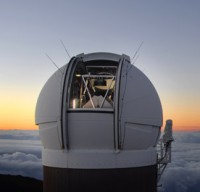Photographing the Universe

A new standard has been set in astronomy as the Pan-STARRS sky survey telescope begins scanning the skies nightly with the world's largest digital camera.
While searching for asteroids that threaten Earth, the PS1 telescope is also mapping the Universe and investigating its biggest mysteries: dark matter and dark energy.
Three UK universities are part of the international science consortium designing the telescope's science mission. Scientists from the University of Durham, University of Edinburgh and Queen's University Belfast are spearheading searches for supernovae, Near-Earth asteroids and the fundamental nature of the Universe.
Conceived and designed at the University of Hawaii Institute for Astronomy, the observatory sits atop the dormant volcano Haleakala.
With a 1.8-metre primary mirror, the PS1 telescope is modest in size, but it has an extraordinary field of view— seven times bigger than typical survey instruments.
Mounted on the back of the telescope is the refrigerator-sized 1400 megapixel camera that makes PS1 the world's most powerful survey telescope. This sensitive digital camera was regarded as an unreachable dream just a few years ago.
PS1 takes an image every 30 seconds, each one 200 times larger than a typical photograph. The wealth of astronomical information in these images can only be extracted by a complex computing endeavour that processes the images, identifies and catalogues astronomical objects, and classifies their attributes.
The completed archive will be several peta-bytes in size, enough to fill several thousand top-end PC hard disks.
"PS1 will generate the largest ever multi-coloured survey of the cosmos. Alongside supercomputer simulations of the Universe, these data will help us understand the life cycles of galaxies and, if we are very lucky, the nature of the mysterious dark matter and dark energy that control the evolution of our cosmos," said Prof. Carlos Frenk of Durham University, the UK's member on the Pan-STARRS board.
The Royal Observatory Edinburgh has a long history of survey astronomy. Prof. Alan Heavens of the University's Institute for Astronomy (IfA) said: "PS1 is a beautifully-designed instrument that will enable lots of different science, and IfA scientists will be playing key roles in many areas."
Prof. Heavens uses Einstein's theory of general relativity to understand how galaxies can bend light and act as cosmic lenses: "We co-lead the gravitational lensing programme, looking for signs of gravitational bending. This is an indicator of dark matter and dark energy, responsible for the dominant force driving the acceleration of the Universe.
"We are also looking at the clustering of galaxies to help us better understand the contents of the Universe and its past and future."
"There are still big challenges ahead for us. Pan-STARRS has immense potential for mapping the distribution of matter in the Universe, even the unseen dark matter. Our goal is to do this over the majority of the sky for the first time."
One novel aspect is the ability to track fast moving objects and exploding stars across nearly the whole sky.
Prof. Stephen Smartt of Queen's University and Chair of the Pan-STARSS Science Council said: "The huge camera lets us map about one sixth of the sky every month, in five different colours. We compare every image with one taken previously and try to track everything that either moves or flashes.
"Already we have discovered hundreds of supernovae, some of them the most luminous explosions known."
Pan-STARRS (Panoramic Survey Telescope & Rapid Response System) exploits the unique combination of superb observing sites and technical and scientific expertise available in Hawaii.
The project plans to build the full four-telescope Pan-STARRS array that will quadruple the light-gathering capability of PS1.
Funding for the development of the observing system has been provided by the U.S. Air Force.
The PS1 Surveys have been made possible through contributions of the PS1 Science Consortium (PS1SC): the Institute for Astronomy, the University of Hawaii; the Pan-STARRS Project Office; the Max-Planck Society and its participating institutes, the Max Planck Institute for Astronomy, Heidelberg, Germany and the Max Planck Institute for Extraterrestrial Physics, Garching, Germany; the Johns Hopkins University; the University of Durham; the University of Edinburgh; the Queen's University Belfast; the Harvard-Smithsonian Center for Astrophysics; the Los Cumbres Observatory Global Telescope Network, Inc.; and the National Central University of Taiwan.

